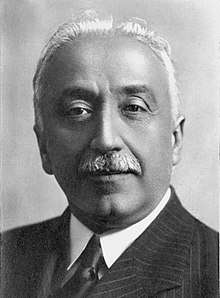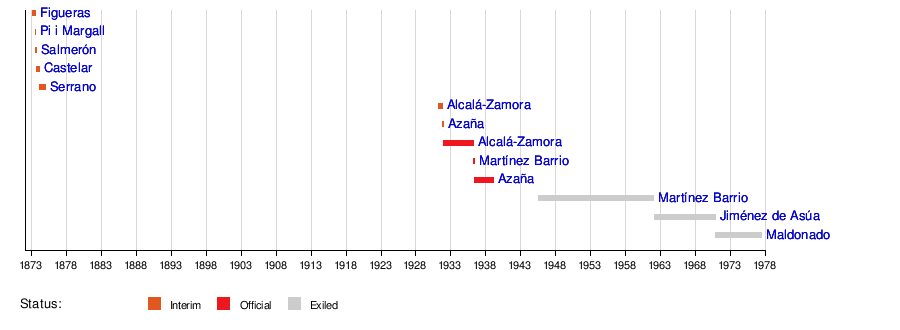President of the Republic (Spain)
President of the Republic (Spanish: Presidente de la República) was the title of the head of state during the Second Spanish Republic (1931–39). The office was based on the model of the Weimar Republic, then still in power in Germany, and a compromise between the French and American presidential systems.[1]
| President of the Republic Presidente de la República  | |
|---|---|
-Flag_Variant.svg.png) | |
 | |
| Precursor | King of Spain |
| Formation | 14 April 1931 |
| First holder | Niceto Alcalá-Zamora |
| Final holder | Manuel Azaña |
| Abolished | 3 March 1939 |
| Succession | Francoist dictatorship |
The "Republican Revolutionary Committee" set up by the Pact of San Sebastián (1930),[2] considered the "central event in the opposition to the monarchy of Alfonso XIII",[3] and headed by Niceto Alcalá-Zamora, eventually became the first provisional government of the Second Republic, with Alcalá-Zamora named President of the Republic on 11 December 1931.
Note that Spain is one of the democracies (see President of the Council for the full list of countries) where the term 'president' must be used with care, as it does not solely refer to the head of state but to several distinct offices: President of the Republic for some historical heads of state; President of the Government for the head of the executive; President of the Senate for the speaker of the upper parliamentary chamber, etcetera. This has led to some confusion in countries where the term president refers solely to the head of state, such as the United States: several incidents involved high-profile American politicians calling the Spanish head of government "President," including George W. Bush in 2001,[4] Jeb Bush in 2003,[5] and most recently, Donald Trump in September 2017.[6] With Spain a constitutional monarchy since 1975, the current monarch is head of state.
First Spanish Republic (1873–74)
Following the abdication of Amadeo I on 10 February 1873, the short-lived First Republic (1873–74) had four heads of state (officially, Presidents of the Executive Power): Estanislao Figueras, Pi i Margall, Nicolás Salmerón, and Emilio Castelar.
| Name | Term start | Term end | Political Party | |
|---|---|---|---|---|
| Executive Power of the First Republic.[7] Presidents: | ||||
 | Estanislao Figueras | 12 February 1873 | 11 June 1873 | Democratic Federal Republican Party |
 | Francisco Pi i Margall | 11 June 1873 | 18 July 1873 | Democratic Federal Republican Party |
.jpg) | Nicolás Salmerón | 18 July 1873 | 7 September 1873 | Progressive Party |
.jpg) | Emilio Castelar | 7 September 1873 | 3 January 1874 | Republican Possibilist Party |
On the eve of the pronunciamiento. (coup d'état) of 3 January 1874, General Pavia sent for Francisco Serrano y Domínguez take to the leadership. Serrano took the title of president of the executive and he continued at the end of December 1874 when the Bourbons were restored by another pronunciamiento.
| Image | Name | Term start | Term end |
|---|---|---|---|
.jpg) | Francisco Serrano y Domínguez | 3 January 1874 | 30 December 1874 |
Second Spanish Republic (1931–39)
Following the abdication of Alfonso XIII on 14 April 1931, there was no official head of state, meaning that the Prime Minister was, in effect, the highest office in the land. Niceto Alcalá-Zamora assumed the new role of President of the Republic, the effective head of state, after the approval of the new Constitution in December of 1931. Manuel Azaña remained as Prime Minister, head of the government, until 12 September 1933.
Presidents (Prime Ministers) of the Provisional Government of the Republic
| Name | Term start | Term end | Political Party | |
|---|---|---|---|---|
 | Niceto Alcalá-Zamora | 14 April 1931 | 14 October 1931 | Liberal Republican Right |
 | Manuel Azaña | 14 October 1931 | 11 December 1931 | Republican Action |
Presidents of the Republic
| Name | Term start | Term end | Political Party | |
|---|---|---|---|---|
 | Niceto Alcalá-Zamora | 11 December 1931 | 7 April 1936 | Liberal Republican Right |
 | Diego Martínez Barrio (interim) | 7 April 1936 | 11 May 1936 | Republican Union (Popular Front) |
 | Manuel Azaña | 11 May 1936 | 3 March 1939 | Republican Left (Popular Front) |
With Franco's victory imminent, a National Council of Defense was established to negotiate a peace settlement with the Nationalists. By this point, Franco effectively had military control of the whole country.
Presidents of the National Council of Defense (Republican Zone)
| Name | Term start | Term end | Political Party | |
|---|---|---|---|---|
.svg.png) | Segismundo Casado López (interim) | 4 March 1939 | 13 March 1939 | Military |
.svg.png) | José Miaja Menant | 13 March 1939 | 27 March 1939 | Military |
Fall of the Republic
On 27 February 1939, after both France and the United Kingdom had recognised Franco's military victory, President Manuel Azaña, exiled in France, resigned. The following week, the so-called Casado's Coup against Prime Minister Negrín's government[8] led to the creation of the National Defence Council which attempted, unsuccessfully to negotiate terms, with Franco breaking off talks motu proprio.[9] Following Franco's final offensive at the end of March 1939, the Republic fell.
Presidents of the Spanish Republic in exile (1939–77)
| Name | Term start | Term end | Political Party | |
|---|---|---|---|---|
 | Diego Martínez Barrio (Official interim successor of Azaña for being president of the Congress and an important figure for most of the non-communist anti-Franco forces but for his enmity with Juan Negrín he did not take office until 1945). | 4 March 1939 | 17 August 1945 | Republican Union (Popular Front) |
 | Juan Negrín (Prime Minister in the exile until the proclamation as president of Diego Martínez Barrio, who dismissed him). | 31 March 1939 [10][11] | 17 August 1945 | Republican Union (Popular Front) |
 | Diego Martínez Barrio | 17 August 1945 | 1 January 1962 | Republican Union (Popular Front) |
 | Luis Jiménez de Asúa | 11 February 1962 | 16 November 1970 | PSOE (Popular Front) |
.svg.png) | José Maldonado González | November 1970 | 1 July 1977 | Republican Left (Popular Front) |
Timeline

References
- Payne, Stanley G. (1993) Spain's First Democracy: The Second Republic, 1931–1936, pp. 62–3. Univ of Wisconsin Press. Google Books. Retrieved 2 October 2013.
- Conversi, Daniele (2000) The Basques, the Catalans, and Spain: Alternative Routes to Nationalist Mobilisation, p. 38. University of Nevada Press. Google Books. Retrieved 2 October 2013.
- Preston, Paul (2002) Revolution and War in Spain, 1931–1939, p. 192. Routledge. Google Books. Retrieved 2 October 2013.
- "Joint Press Conference with President George W. Bush and President Jose Maria Aznar" The White House. Retrieved 2 October 2013.
- "Jeb Bush slips on Spanish history" CNN. Retrieved 2 October 2013.
- "Donald Trump's tweet on Mariano Rajoy's visit to the United States". Twitter. 26 September 2017. Retrieved 26 September 2017.
- The official name of " Executive Power " between 1868 and 1874, designates a transitory and undefined authority without a constitutional configuration.
- "War in Spain: Casado's Coup" TIME. Retrieved 2 October 2013.
- (in Spanish) "Segismunco [sic] Casado: el final de una guerra" ABC. Retrieved 2 October 2013.
- Herrerín López, Ángel (2007), El dinero del exilio: Indalecio Prieto y las pugnas de posguerra (1939-1947), Siglo XXI de España Editores, pág.3
- Romero Samper, Milagrosa (2005), La oposición durante el franquismo, Encuentro, pág.91